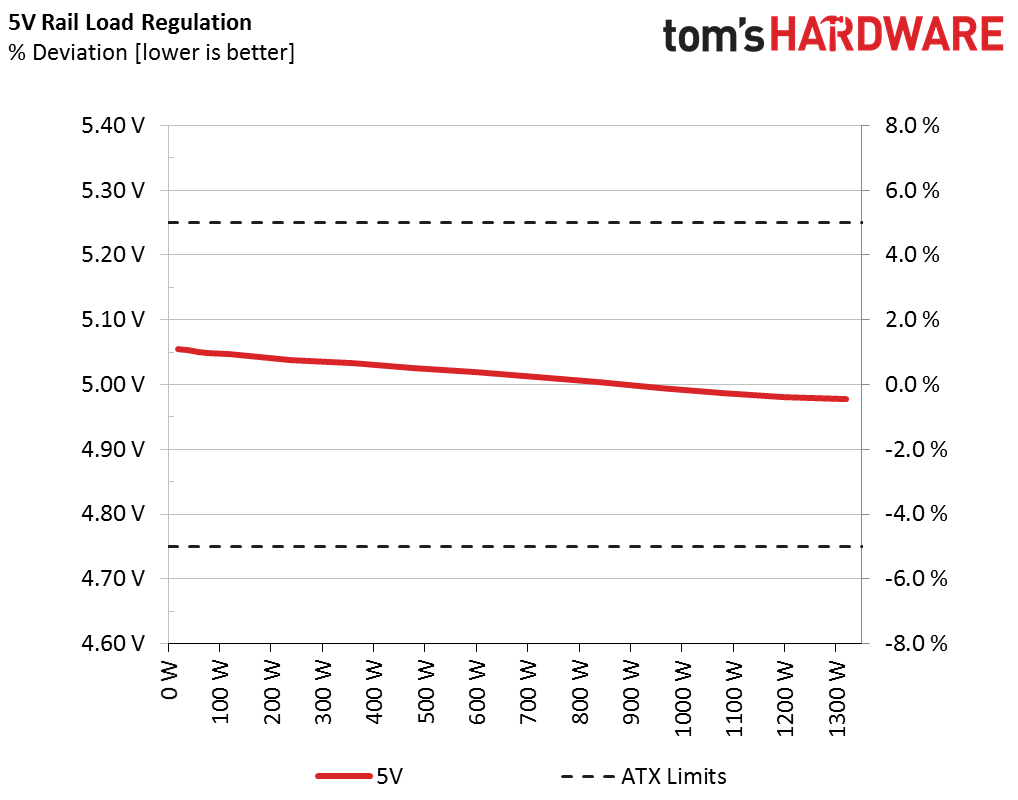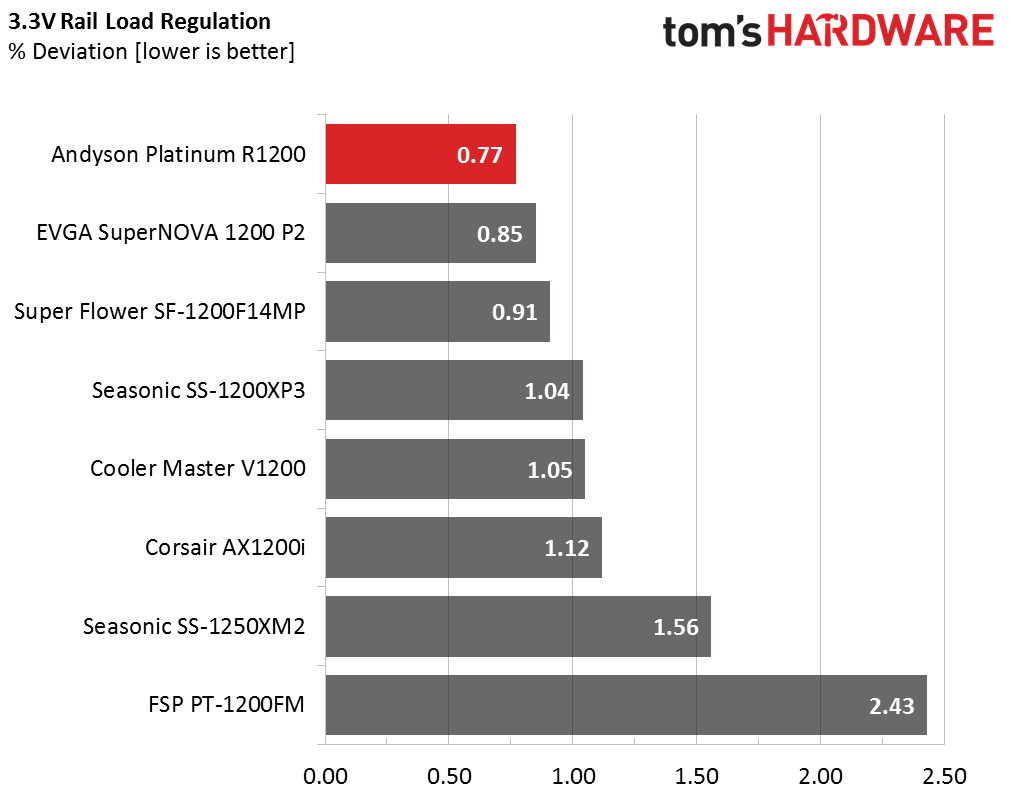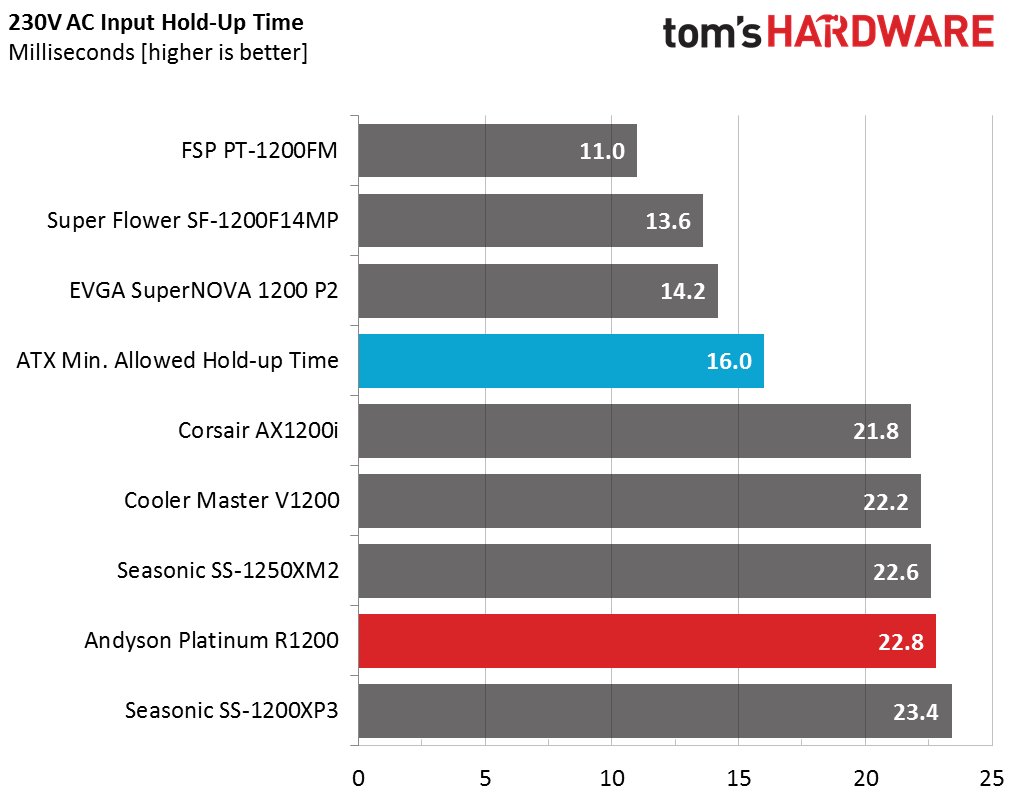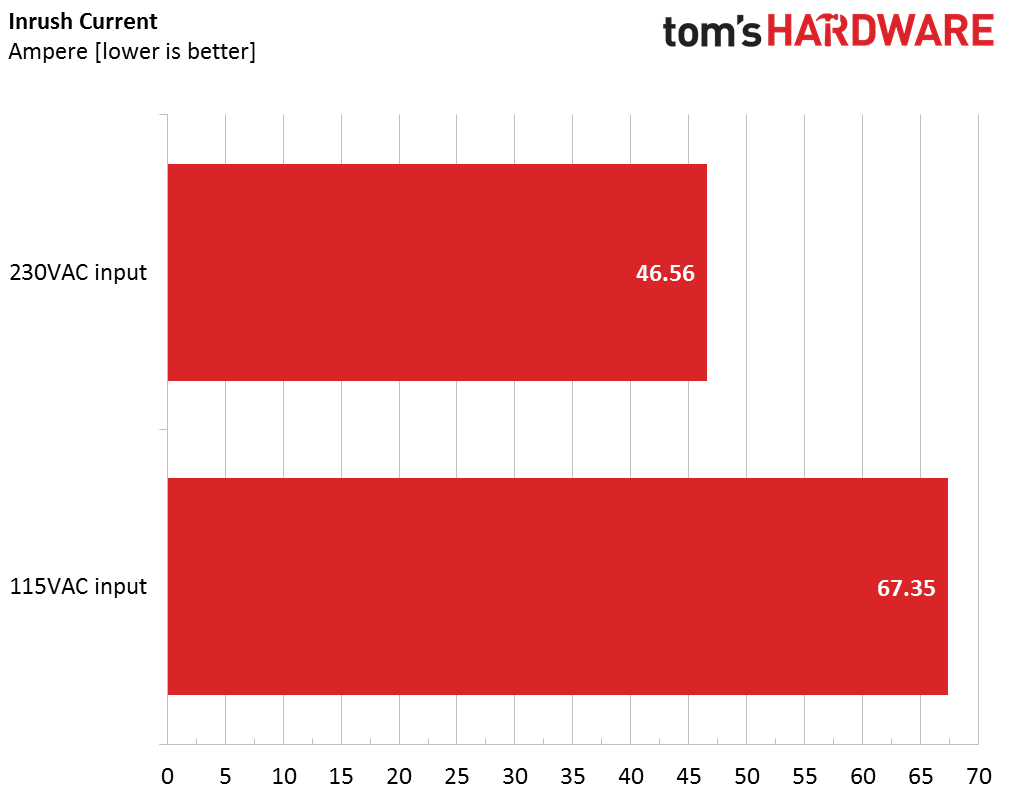Andyson Platinum R1200 Power Supply Review
Why you can trust Tom's Hardware
Load Regulation, Hold-Up Time And Inrush Current
To read about our PSU tests in-depth, please check out How We Test Power Supply Units. Load Regulation testing is detailed here.
Primary Rails And 5VSB Load Regulation
The following charts show the voltage values of the main rails, recorded over a range from 40W to the maximum specified load, and the deviation (in percent) for the same load range. You will also find a chart showing how the 5VSB rail deals with the loads we throw at it.








Hold-Up Time
Our hold-up time tests are described in detail here.


The registered hold-up time is much higher than 16ms, so the PSU passes this test with flying colors. In fact, Andyson registers the second-highest hold-up time in this category. As you see in the chart, a majority of high-end PSUs achieve more than 20ms of hold-up time because they use large bulk caps in the APFC converter.
Inrush Current
For details on our inrush current testing, please click here.


The inrush current we measured is on the high side with 230V input, an expected outcome due to the bulk caps' increased capacity. Nonetheless, the difference between the other PSUs in this category is small, with the only exception being Corsair's AX1200i, which has a very low inrush current for its capacity. With 115V, input we observe the highest reading we've ever measured.
Load Regulation And Efficiency Measurements
The first set of tests reveals the stability of the voltage rails and the PSU's efficiency. The applied load equals (approximately) 10 percent to 105 percent of the maximum load the supply can handle, in increments of 10 percentage points.
Get Tom's Hardware's best news and in-depth reviews, straight to your inbox.
We conduct two additional tests. In the first metric, we stress the two minor rails (5V and 3.3V) with a high load while the load at +12V is only 0.10A. This test reveals whether the PSU is Haswell-ready or not. In the second test, we determine the maximum load the +12V rail can handle while the load on the minor rails was minimal.
| Test | 12V (A/V) | 5V(A/V) | 3.3V(A/V) | 5VSB (A/V) | DC/AC (W) | Efficiency (%) | Fan Speed (RPM) | Noise dB(A) | In/Out (°C) | PF/AC (V) |
|---|---|---|---|---|---|---|---|---|---|---|
| 1 | 8.093 | 1.983 | 1.956 | 0.990 | 119.78 | 84.17 | 1160 | 38.3 | 36.94 | 0.941 |
| 12.134 | 5.047 | 3.368 | 5.036 | 142.31 | 41.15 | 115.0 | ||||
| 2 | 17.207 | 2.968 | 2.939 | 1.190 | 239.58 | 90.88 | 1200 | 39.4 | 38.06 | 0.977 |
| 12.132 | 5.038 | 3.365 | 5.029 | 263.61 | 42.48 | 115.0 | ||||
| 3 | 26.705 | 3.475 | 3.445 | 1.390 | 359.80 | 92.26 | 1200 | 39.4 | 38.52 | 0.987 |
| 12.123 | 5.033 | 3.363 | 5.023 | 390.00 | 43.01 | 114.8 | ||||
| 4 | 36.193 | 3.974 | 3.925 | 1.590 | 479.58 | 92.43 | 1405 | 44.1 | 39.26 | 0.992 |
| 12.106 | 5.026 | 3.360 | 5.017 | 518.85 | 43.94 | 114.8 | ||||
| 5 | 45.355 | 4.977 | 4.912 | 1.795 | 599.53 | 91.77 | 1495 | 46.7 | 40.25 | 0.994 |
| 12.106 | 5.019 | 3.358 | 5.009 | 653.27 | 45.19 | 114.6 | ||||
| 6 | 54.549 | 5.982 | 5.889 | 1.995 | 719.52 | 91.35 | 1495 | 46.7 | 41.11 | 0.995 |
| 12.095 | 5.011 | 3.355 | 5.003 | 787.65 | 46.28 | 114.5 | ||||
| 7 | 63.730 | 6.998 | 6.889 | 2.200 | 839.40 | 90.80 | 1495 | 46.7 | 42.3 | 0.996 |
| 12.087 | 5.004 | 3.352 | 4.995 | 924.45 | 47.8 | 114.4 | ||||
| 8 | 72.943 | 8.008 | 7.883 | 2.402 | 959.30 | 90.09 | 1495 | 46.7 | 43.86 | 0.996 |
| 12.077 | 4.994 | 3.348 | 4.989 | 1064.80 | 49.67 | 114.3 | ||||
| 9 | 82.600 | 8.518 | 8.397 | 2.405 | 1079.30 | 89.34 | 1495 | 46.7 | 44.89 | 0.997 |
| 12.067 | 4.987 | 3.346 | 4.985 | 1208.10 | 51.02 | 114.1 | ||||
| 10 | 92.012 | 9.038 | 8.883 | 3.015 | 1199.19 | 88.48 | 1495 | 46.7 | 45.85 | 0.997 |
| 12.058 | 4.981 | 3.344 | 4.972 | 1355.40 | 52.13 | 114.0 | ||||
| 11 | 102.048 | 9.046 | 8.886 | 3.015 | 1319.17 | 87.59 | 1495 | 46.7 | 47.42 | 0.997 |
| 12.048 | 4.977 | 3.341 | 4.970 | 1506.00 | 54.35 | 113.8 | ||||
| CL1 | 0.099 | 12.007 | 12.005 | 0.000 | 101.56 | 78.48 | 1495 | 46.7 | 44.56 | 0.937 |
| 12.139 | 4.999 | 3.360 | 5.056 | 129.41 | 49.11 | 115.0 | ||||
| CL2 | 99.937 | 1.002 | 1.003 | 1.002 | 1218.45 | 88.68 | 1495 | 46.7 | 45.96 | 0.997 |
| 12.058 | 5.017 | 3.352 | 5.008 | 1374.00 | 52.12 | 114.0 |
The requirements of 80 PLUS Platinum require 90-percent efficiency under a 20-percent load, 92 percent with a 50-percent load and 89 percent under full load. The Power Factor (PF) should be at least 0.95 with 50 percent of the unit's max-rated capacity load. As you can see from the table, this unit passes the 20-percent load efficiency requirement with ease.
However, the aforementioned load level efficiency is a tad lower than 92 percent, and under a full load, it's almost 0.5 percent lower than the minimum-allowed efficiency of an 80 PLUS Platinum rating. Fortunately for Andyson, the 80 PLUS organization tests at only 23 °C, while we run our benchmarks at a much higher ambient temperature. To wrap up, under normal conditions, the R1200 meets the 80 PLUS requirements, though we'd like to see more headroom.
The PSU does fine in the load regulation section, with its +12V and 3.3V rails within one-percent deviation, while the 5V and 5VSB rails are within two percent. In addition, it easily delivers its full power (and even more) at operating temperatures above 47 C during our overload test. We should note that it's extremely important to test PSUs at high temperatures, since those conditions ensure the internals can handle tough situations.
Our tests inside the hotbox reveal that the fan profile is aggressive; it pushes rotational speeds as high as possible once the ambient temperature goes over 40 °C, regardless of the PSU's load. Since this is a highly efficient unit, and heat dissipation is low, we believe that Andyson could provide a more conservative ramp-up. Thankfully, the fan that Andyson uses is quiet most of the time. At full speed, though, it definitely makes its presence known.
Current page: Load Regulation, Hold-Up Time And Inrush Current
Prev Page A Look Inside And Component Analysis Next Page Efficiency, Temperatures And Noise
Aris Mpitziopoulos is a contributing editor at Tom's Hardware, covering PSUs.